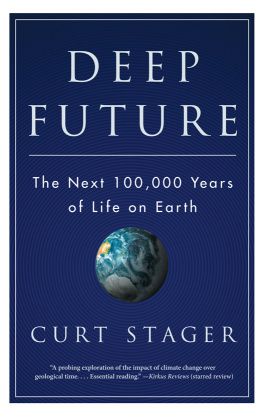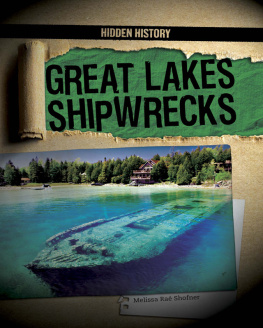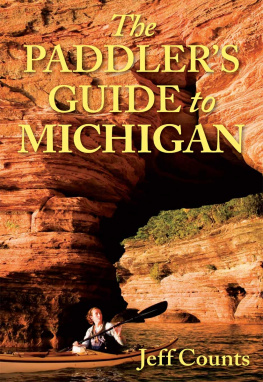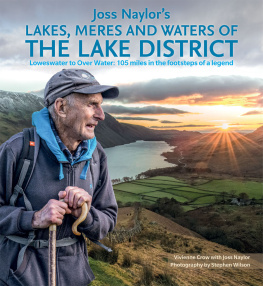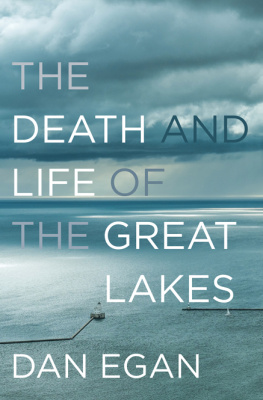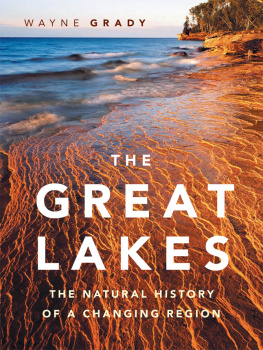
STILL WATERS

ALSO BY CURT STAGER
Your Atomic Self (2014)
Deep Future (2011)
Our Future Earth (2011)
Field Notes from the Northern Forest (1998)
STILL WATERS

THE SECRET WORLD OF LAKES


Curt Stager

W. W. NORTON & COMPANY
Independent Publishers Since 1923 | New York | London
Copyright 2018 by Curt Stager
All rights reserved
First Edition
For information about permission to reproduce selections from this book,
write to Permissions, W. W. Norton & Company, Inc.,
500 Fifth Avenue, New York, NY 10110
For information about special discounts for bulk purchases, please contact
W. W. Norton Special Sales at specialsales@wwnorton.com or 800-233-4830
Book design by Brooke Koven
Production manager: Anna Oler
JACKET DESIGN BY PLOY SIRIPANT
JACKET PHOTOGRAPH KARY JOHNSON
The Library of Congress has cataloged the printed edition as follows:
Names: Stager, Curt, author.
Title: Still waters : the secret world of lakes / Curt Stager.
Description: First edition. | New York, NY : W.W. Norton & Company, 2018. |
Includes bibliographical references.
Identifiers: LCCN 2017060910 | ISBN 9780393292169 (hardcover)
Subjects: LCSH: Lakes. | Lake ecology. | Lake conservation. |
NatureEffect of human beings on
Classification: LCC GB1603.2 .S7 2018 | DDC 551.48/2dc23
LC record available at https://lccn.loc.gov/2017060910
ISBN 978-1-63149-354-6 (e-book)
W. W. Norton & Company, Inc.,
500 Fifth Avenue, New York, N.Y. 10110
www.wwnorton.com
W. W. Norton & Company Ltd.,
15 Carlisle Street, London W1D 3BS
FOR DAN, JOE, AND DAD
CONTENTS


What is life without stars?
And trees to see them through?
And a lake for a cool, clear view
when you need a reflection
to flip perspectives,
and the world?
HANNA CROMIE
STILL WATERS
I come down to the water to cool my eyes. But everywhere I look I see fire; that which isnt flint is tinder, and the whole world sparks and flames.
ANNIE DILLARD , Pilgrim at Tinker Creek
C OME DOWN to the edge of the lake. What do you see?
A sparkling blue plain, flat as a field for sailing on? A fishing hole? Perhaps a place where monsters or spirits lurk, a reservoir to water and refresh a city, or a revered symbol of wilderness. It can be all of those things and more, but most of all it is a mirror. What you see in a lake is a reflection of yourself and a glimpse of your relationship to the natural world.
That is what this book is about.
Come to the lake again when the air is restless and take a closer look. Is it really blue? The wind sweeps the surface into dunes that carry the colors of weather, water, and shore, a fluid mosaic that changes faster than you can describe it. Peer into the approaching waves when the Sun shines through them and they may glow green, brown, or multiple shades of blue depending upon the season and the kinds of plankton within them. If you scoop a glass full there may be no apparent color at all, and if you try it in winter the water itself may have turned to glass.
For the most profound experiences, however, come to the lake when the air is calm and the water is still. Now it resembles a hole in the Earth through which to view a subterranean sky, an illusion that also reflects reality. When Henry David Thoreau wrote that Heaven is under our feet as well as over our heads, he meant it metaphorically, but there really is a sky down there, almost 8,000 miles (12,750 km) away on the far side of the planet. Suddenly, you and the world around you are transformed into something more miraculous and precarious, a mote of life amid a thin plankton of planets within a deep lake of space.
Step even closer, right up to the rim. Now you can see in the shallows that there is a bottom to it, and that the blue plain was yet another mirage. The lake is not a flat sheet but, like you, a body of water atop a landscape whose contours continue beneath it. If your imagination removes the water to reveal that hidden terrain, you will be reminded that much is concealed beneath the surface of daily life. The lake itself takes the shape of a mountain of water that has been clipped, flipped, and planted top-down in the earth. The living community within it also mirrors the layering of mountain habitats, with life least abundant in the least accessible zones where oxygen can be perilously scarce.
Lakes are secret worlds within worlds hiding in plain sight. If you come close enough to sweep your fingers through the water, a fish might dart away at your approach. The fish will then vanish into places beneath the reflections where rich and varied forms of life thrive unseen, especially in the realm of the very small. Creatures of legend take form and lend their names to the nymphs, hydras, and cyclopses who live there.
Now press a wet fingertip against your brow. The coolness of the moist smear is the work of evaporating particles, the primal elements of existence. Early Greeks named them little lumps of stuff (mole-cules) and indivisibles (a-toms) without knowing their sizes or properties or even proving their presence. Many of us think of them only as squiggles on blackboards or the stuff of dangerous chemicals and bombs, but they link us to all life, the planet, and the deep history of the universe.
That transformation of water into air reveals elemental connections between you and the lake. Every breath you draw invites lake water vapor into your body, and moisture from your lungs melts into the surface of the lake with each humid breath you release. You also run the alchemy backward, turning air into water. One in ten of your tears is metabolic water that your cells crafted from airborne oxygen, some of which may have been made from water molecules by plankton in the lake before you.
On the surface this book is about lakes, but it is more than that. It is also about evolutionary processes that anchor the roots of all life in water. It is about inanimate air, water, and stone becoming an alga, then a shrimp-like copepod, then a trout, then a loon or, perhaps, a person. It is about tracing your ancestral connections to distant aquatic relatives who are too small to see. It is about a tiny dab of tissue morphing into a wriggling tadpole who later becomes a frog. It is also about people maturing as I did in my growth from inquisitive kid to scientist, and as our own species is doing in this remarkable new slice of Earth history, the Anthropocene Epoch, or the Age of Humans.
Next page

